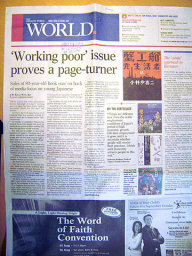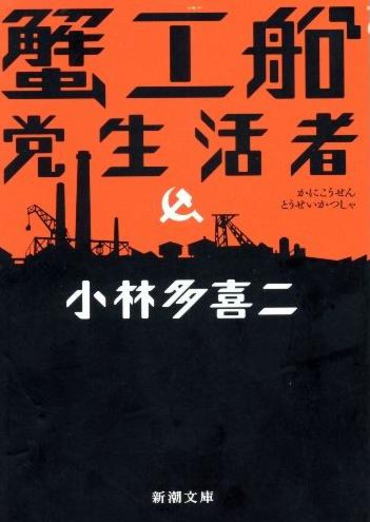| Tweet |

から転載。 2008-08-18 08:37:03 初版以来80年ぶりに突然押し寄せた小説「蟹工船」ブームを、The Straits Timesの東京通信員がこんな風に伝えている。「メディアの後押しがあって若者の間で売り上げをぐんぐん伸ばしている」。 ============================================= 記事は次のように続いている。 ⇒ 現代の「ワーキング・プア」の窮状をそのまま写したような小説が、最近2、3ヶ月、ベストセラー・トップの座を占めている。実はこの小説、マルクス主義作家の小林多喜二が80年前に書いたものだ。 出版元の新潮社によれば、購読者の大半は10代後半から40代の労働人生真っ盛りの人たちだという。多くは「ワーキング・プア」の言葉通り、生活するのがやっとで結婚して家族を持つことなど、もちろんできない。 以下、記事は大要次のように続いていく。 ⇒ 小説「蟹工船」はオホーツク海で蟹を捕って缶詰にする労働に従事する低賃金労働者の悲惨な生活を描いたもの。2006と2007年に漫画版が出版されたがそれほど注目されなかった。 「蟹工船」が注目されたのは、毎日新聞で作家二人が「格差社会」について対談し、今日のフリーター労働者の状況が1920年代に「蟹工船」で描かれている労働者の姿とそっくりだと、作家・雨宮処凛が指摘してからだ。 以後それに同調する発言が、他のマスメディアなどでも続き、「蟹工船」ブームが巻き起こっていく。「蟹工船」現象が起こるまで毎年5千部ほどしか売れなかった新潮社文庫版が、今年だけで48万部を売って、一気に総売上高160万部に達した。 記事はさらにこう指摘する。 ⇒ いま日本には年収200万円以下の人が1,000万人以上いる。多くは1990年から続く「新自由主義」経済の犠牲者だ。小泉純一郎元首相時代に深刻化したと言われている。多くの若者は高校や大学を卒業しても就職できない。 6月に7人を殺害し10人を負傷させた東京の秋葉原事件の容疑者は、「ワーキング・プア」の典型例である。 最後に早稲田大学の十重田裕一(とえだ・ひろかず)教授の次の指摘で記事は結ばれている。 ⇒ 「終身雇用がなくなり、人々は年金を受けとれるかるかどうかも不確かです。そうした不安感がこの小説に人を引きつけていると思います」 --------------------------------- シンガポールのストレーツ・タイムズ紙の英文該当記事はこちら ⇒ http://www.straitstimes.com.sg/Asia/Asia/Story/STIStory_267425.html 'Working poor' issue proves a page-turner According to publisher Shinchosha, most of those who bought the book are people in the prime of their working life, from the late teens to the late 40s. But they are presumed to be mostly members of Japan's 'working poor', a phrase coined by the media to describe people who do not even earn enough to make ends meet, let alone think of getting married or starting a family. Based on a true story, Kani Kosen tells of the diabolical existence of underpaid workers on board a ship that catches and cans crabs in the Sea of Okhotsk and the workers' attempts to improve their lot. A manga version of the story first appeared in November 2006, followed by another version a year later. But both made little impact. The big break came in January this year when the Mainichi Shimbun daily carried a lengthy dialogue between two writers on the theme of the widening gap between the rich and poor in Japan. They kicked off the dialogue with casual references to the book. Ms Karin Amemiya, a punk rocker and right-wing activist who turned to writing on the problems of the young, said: 'It so happens that yesterday I read this book called Kani Kosen written in the 1920s. The situation it describes is exactly like those of today's freeters.' 'Coincidentally,' said writer and university professor Genichiro Takahashi, 'I read the book recently as I had to teach a class.' His students, he said, were able to empathise with the story. According to Ms Amemiya, young Japanese regard what Kani Kosen says to be real because their own labour conditions have become so terrible. The Mainichi article was followed a month later by a report in the influential Asahi Shimbun newspaper about Kobayashi's alma mater inviting essays on impressions of Kani Kosen to mark the 75th anniversary of his death. Some 120 essays were received, including from China. The media attention subsequently spurred sales of the book at several bookstores in Tokyo. Soon, Shinchosha could not bring out enough copies to meet demand. Until then, about 5,000 copies of the book were sold each year. This year alone, the company has so far moved 480,000 copies, according to Shinchosha spokesman Takashi Machii. Total sales since its first publication in 1953 as a paperback has reached 1.6 million copies. Mr Machii could not recall any other book enjoying boom years after it was first brought out. The 'working poor' issue continues to haunt Japan as it could have far-reaching implications for the nation's pension system, which depends on workers supporting the retired elderly. Prime Minister Yasuo Fukuda said in Parliament last October that there was no official definition of 'working poor' but that they probably included freeters, part-timers, families with single parents and those living under the poverty line. There are said to be as many as 10 million Japanese who earn less than two million yen (S$25,400) a year. Many are the victims of economic liberalisation policies that had been slowly put in place since the 1990s. Former premier Junichiro Koizumi is often accused of exacerbating the problem, as it was during his administration in the early 2000s that Japanese companies were encouraged to substitute permanent staff with cheaper part-timers so that they could be more competitive internationally. As a result of such corporate strategies, many young Japanese were unable to find permanent employment after graduation from high school or university. After working for several years as part-timers, they find themselves rejected for permanent jobs even when they are available, as most employers still prefer to hire fresh graduates. Incidentally, the suspect behind the stabbing rampage in Tokyo's Akihabara district in June, which saw seven dead and 10 injured, is a typical example of the working poor. Deep disenchantment with society has been cited as a possible reason for the crime. Explaining the newfound success of Kani Kosen, Professor Hirokazu Toeda of Tokyo's Waseda University told Reuters: 'Things are different now from the stable employment conditions of Japan's period of high economic growth. 'Life-time employment is gone and it is uncertain whether people will receive their pensions. I think such insecurity attracts people to this text.'
gataro-cloneの投稿
蟹工船:「ワーキング・プア」問題がベストセラーを生む【シンガポール英字紙】
テーマ:格差問題
「ワーキング・プア」問題でベストセラーが生まれる。こんな見出しがシンガポールの英字紙国際面トップを飾っている。
Sales of 80-year-old book soar on back of media focus on young Japanese
By Kwan Weng Kin, Japan Correspondent
TOKYO: A novel that critics say perfectly mirrors the plight of today's 'working poor' in Japan has been nearly topping bestseller charts for the past few months.
However, the book Kani Kosen (Crab Canning Ship) was actually written almost 80 years ago by Marxist writer Takiji Kobayashi.
|
|
▲このページのTOPへ HOME > 政治・選挙・NHK52掲示板
フォローアップ:
|
|
投稿コメント全ログ コメント即時配信 スレ建て依頼 削除コメント確認方法
|
|
 題名には必ず「阿修羅さんへ」と記述してください。
題名には必ず「阿修羅さんへ」と記述してください。
掲示板,MLを含むこのサイトすべての
一切の引用、転載、リンクを許可いたします。確認メールは不要です。
引用元リンクを表示してください。
|
|
|
|
|
|
|
|